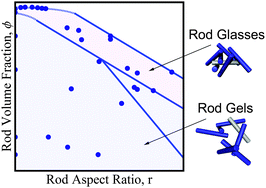We review the diverse range of materials made up of rod-shaped colloids. A common feature of such suspensions is the strong and efficient contribution of rods to the material's solid-like rheological properties such as elastic modulus and yield stress. Colloidal rod suspensions span from biomaterials such as f-actin and fd virus to inorganic materials such as boehmite and hematite, and to commercial fibers such as cellulose. We argue that, depending on the strength of pair potential interactions, such rod suspensions form microstructures that vary between the two limits of heterogeneous fractal clusters and homogeneous fiber networks. The volume fraction range for transition between these two limiting cases is strongly aspect ratio dependent. The two limiting microstructures can be distinguished by differences in the scattering vector dependence of their structure factors, as long as the range of scattering vector probed is sufficient to span regimes both above and below qL ≈ 1. Here q is the scattering vector and L is the rod length. Theories of the Brownian dynamics of fractal clusters and fiber networks show that the two types of microstructure can lead to the arrested dynamics of gelation and the glass transition, respectively. The volume fraction and aspect ratio dependences of the dynamical slowing down of these two cases differ significantly; we suggest that probing these differences is a convenient way to distinguish between gels and glasses of colloidal rods. This distinction is important to clarify because these microstructures are determinants of rheological properties such as elasticity and yielding. By combining these structural and dynamical ideas about rods, we classify a set of literature measurements on more than fifteen different colloidal materials and thereby distinguish between regimes of gelation and vitrification. We conclude by suggesting directions for future research in the arrested dynamics, the non-linear rheology, and the absolute lower limit of gelation in colloidal rod suspensions.

You have access to this article
 Please wait while we load your content...
Something went wrong. Try again?
Please wait while we load your content...
Something went wrong. Try again?


 Please wait while we load your content...
Please wait while we load your content...